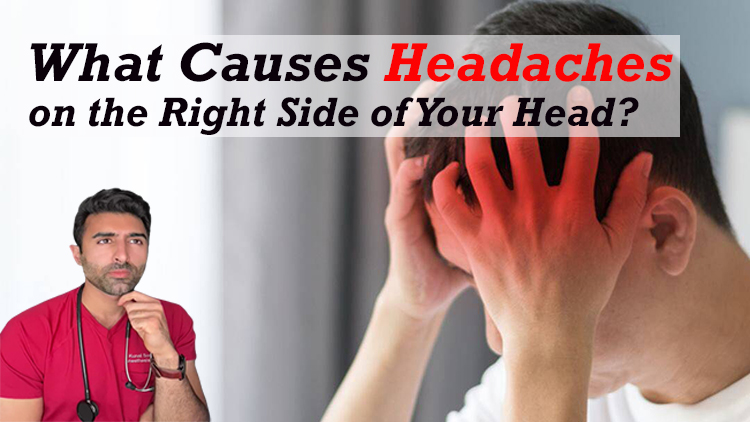
- Causes
- Headache types
- Seeking medical help
- Treatment
- Quick relief
- Diagnosis
- Summary
A headache on only the right side of your head may result from migraine or a tension headache. But it can also be an indicator of an underlying condition.
Headaches can cause a dull throbbing or an intense ache and pain in different areas, including the right side of your scalp, base of your skull, and your neck, teeth, or eyes.
While headaches can be uncomfortable, they’re unlikely to be “brain pain.” The brain and skull don’t have nerve endings, so they won’t cause pain directly. Instead, a wide range of factors can affect headaches, from lack of sleep to caffeine withdrawal. Migraine, meanwhile, is a neurological condition.
There are many types of headaches, but only certain types will be felt on just the right side of your head. Read on to learn more about these types of headaches, their causes, and how to treat them.
Causes of headaches on the right side
Lifestyle factors
Headaches are most commonly caused from factors like:
- stress
- fatigue
- skipping meals
- muscle problems in your neck
- medication side effects, such as long-term use of over-the-counter (OTC) pain medicine
Infections and allergies
Sinus infections and allergies can cause headaches. Headaches resulting from sinus infections are the result of inflammation, which leads to pressure and pain behind your cheekbones and forehead.
Medications and medication overuse
Excessive use of medication to treat headaches can actually cause headaches. This is the most common secondary headache disorder, and it affects up to 5 percentTrusted Source of the population. Medication overuse headaches tend to be worst upon awakening.
Common causes of medication overuse headaches include:
- Simple analgesics. OTC medications like acetaminophen and nonsteroidal anti-inflammatory drugs (NSAIDs) can cause medication overuse headaches when taken 15 or more days per month.
- Combination pain relievers. Some OTC pain relievers contain a combination of drugs, such as aspirin and caffeine. These can cause headaches when taken 10 or more days per month.
- Triptans, ergotamines, and opioids. These categories of migraine drugs can cause headaches when used 10 or more days per month.
- Caffeine. More than 200 milligrams of caffeine per day can also cause headaches.
Prolonged use of these medications in elevated quantities can leadTrusted Source to structural and functional changes to the brain, leading to headaches. Most people can expect to recover from these changes after discontinuing the use of these drugs.
Neurological causes
- Occipital neuralgia. There are two occipital nerves in the spine of your upper neck that run through the muscles to your scalp. Irritation of one of these nerves can cause shooting, electric, or tingling pain. Often the pain will be on only one side of your head.
- Temporal arteritis. This is a condition in which you have inflamed or damaged arteries that supply blood to your head and brain. This pressure can cause other symptoms, such as vision impairment, shoulder or hip pain, jaw pain, and weight loss.
- Trigeminal neuralgia. This is a chronic condition that affects the nerve that carries sensation from your face to your brain. The slightest stimulation on your face may trigger a jolt of pain.
Medical causes
A variety of medical factors are thought to play a role in causing headaches on the right side. These conditions may increase your risk of right-sided headaches, but not everyone with right-sided headaches will necessarily have all or any of these factors.
Medical causes of right-sided headaches can include:
- genetics
- anxiety and mood disorders
- obstructive sleep apnea
- teeth grinding and jaw clenching
Other causes
More serious causes of headaches that can occur on only one side include:
- trauma
- aneurysm
- tumors, which can be both benign or malignant (cancerous)
- stroke
Only a doctor can diagnose the cause of your headaches.
Types of headaches
There are different types of headaches that can affect you on just the right side of your head, each of which has different and overlapping causes and symptoms. Knowing which type of headache you have can help a doctor diagnose the cause. The most common headaches include:
Tension headaches
Tension headaches are the most common type of headache, occurring in about 75 percent of adults. While they usually affect both sides, they can also be unilateral, or occurring on only one side of your head.
Feels like: A dull ache or a squeezing pain. Your shoulders and neck can also be affected.
Migraine headaches
Migraine attacks can occur on one or both sides of your head, and can result in light and sound sensitivity, nausea and vomiting, blurred vision, or paresthesia (numbness or tingling sensations).
Feels like: A severe throbbing or pulsating sensation.
Before or during a migraine attack, some people will experience auras, which are most often visual. Auras can have positive or negative symptoms. Positive symptoms are due to activation of the central nervous system. Examples of positive symptoms include:
- vision disturbances like zigzag vision or flashes of light
- auditory problems like tinnitus (ringing in your ears) or noises
- somatosensory symptoms like burning or pain
- motor abnormalities like jerking or repetitive movements
Negative symptoms are manifested as a loss of function, which includes loss of vision, loss of hearing, or temporary paralysis.
Cluster headaches
Cluster headaches are often painful and involve only one side of your head. You may also experience restlessness, pale or flushed skin, redness of the affected eye, and a runny nose on the affected side of your face.
Feels like: Intense pain, especially eye pain involving only one eye and radiating to areas of your neck, face, head, and shoulders.
Hormone headaches
The hormone levels in your body can sometimes be a cause of headaches. In particular, a drop in estrogen associated with menstrual cycles can result in migraine attacks. Close to two-thirds of women with migraine experience attacks around the time of their period.
Pregnancy, menopause, and the use of oral contraceptives can all cause hormone level changes that result in headaches.
Feels like: Throbbing pain, often accompanied by nausea and sensitivity to light and sound.
Hemicrania continua
As its name suggests, hemicrania continua is a type of nonstop headache on one half of the head. By definition, the headache lasts for at least 3 months without ceasing. This can include bouts of increased intensity several times per day.
Feels like: Moderate to intense pain on one side of the head that lasts continuously.
Chronic headaches
Chronic headaches occur 15 or more days a month. They can be tension headaches or migraine attacks. Make an appointment with a doctor to diagnose the cause if you’re experiencing chronic headaches.
When to see a doctor
In the case of non-emergency headaches, you should make an appointment to see a doctor if you’re experiencing a change in the frequency or severity of your headaches. Having a headache that lasts more than 2 days or having more than 15 headaches in a month are also reasons to speak with a doctor.
You may also want to visit your doctor if the headache is sudden and severe, wakes you up at night, or gets increasingly worse. You might be referred to a headache specialist.
MEDICAL EMERGENCY
In rare cases, headaches can be an emergency symptom. Call 911 or go to the nearest emergency room if you experience a headache following a trauma, or have a headache along with any of the following symptoms:
- fever
- stiff neck
- weakness
- vision loss
- double vision
- slurred symptoms
- pain near your temples
- increasing pain when moving or coughing
Treating a headache on the right side of your head
Treatment for your headache will depend on what type of headache you’re experiencing, the severity, and the cause. A doctor can help you put together a treatment plan that will work for your situation.
Some treatments will help you to manage the symptoms of your headaches on an as-needed basis. These might include:
- OTC pain relievers
- caffeine
- prescription pain relievers (such as triptans)
- oxygen therapy
Other treatments can be used to prevent headaches. These might make your headaches less frequent or less severe. Examples include:
- antiseizure medication
- beta-blockers
- calcium channel blockers
- antidepressants
- prescription pain relievers (such as indomethacin)
- relaxation techniques
- acupuncture
- yoga
- physical therapy
Quick ways to relieve a headache
There are a few ways to relieve headaches quickly:
- apply a warm compress to the back of the neck
- take a warm shower
- improve your posture to relieve tension from the head, neck, and shoulders
- leave the room and go to a new environment, especially if lights, sounds, or smells are causing the headache or eye strain
- take a quick nap, which can help relieve headaches caused by fatigue
- loosen your hair if it’s up in a ponytail, braid, or bun
- drink more water to avoid dehydration
How a doctor will diagnose your headache
A doctor will conduct a physical exam, and ask about your medical history and the symptoms you are experiencing.
You can prepare for this by having answers to the following:
- When did the pain start?
- What other symptoms are you experiencing?
- Is the headache the first symptom?
- How often are you experiencing the headaches? Are they a daily occurrence?
- Do you have a family history of headaches, migraine attacks, or other relevant conditions?
- Do you notice any obvious triggers?
A doctor may also run different tests to give you a definitive diagnosis. The tests they may run include:
- blood tests, to look for infections of the spinal cord or brain, toxins, or blood vessel problems
- cranial CT scan, to get a cross-sectional view of your brain, which can help diagnose infections, tumors, bleeding in your brain, and brain damage.
- head MRI, for images of blood vessels and your brain, including any abnormalities in the brain and nervous system






